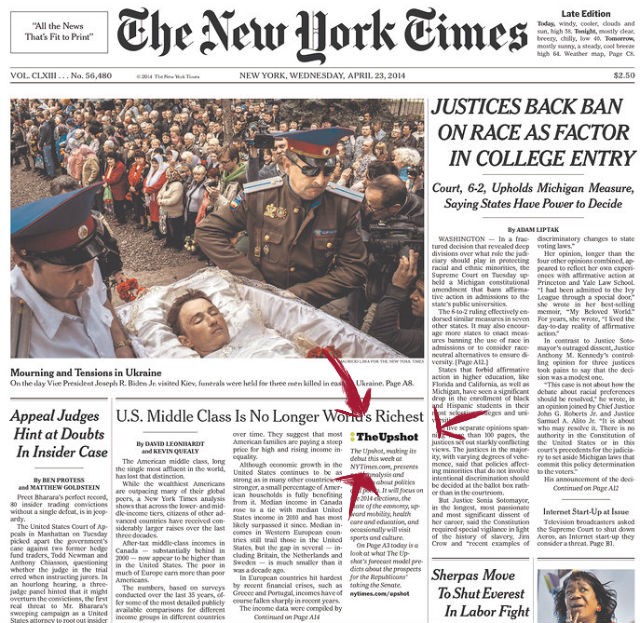In Defense of Explaining Things

For websites meant to help us understand things, the new Explainer Sites — Vox, FiveThirtyEight, et al — are awfully disorienting. We stare them in the face and we cannot quite describe what we are looking at. Are they publications? Some sort of health food? Are they explaining the news to me, or to someone standing behind me? This is the root of the explainer backlash, to whatever extent there is one: The way these confident, assertive sites, in their quest to make us feel smart, end up making us feel like idiots.
Or wait, in true explainer spirit: Maybe we’re just looking at them all wrong?

“Actually journalism” is too narrow to describe what’s going on here, but it gets at something important: These stories are written like verbal interruptions (“No, this study doesn’t show pot wrecks your brain”). Their headlines offer to lift you out of the noise and confusion of your horrible broken Facebook homepage or your endless numbing Twitter stream to a quiet place of understanding; they interrupt your feeds to educate you, then put you back, better equipped to deal with all the monstrous people and brands that you follow.
There are the explicit interruption formats:
– Sorry, But
— No,
— Don’t Worry,
— Relax,
— Good News/Bad News:
And the implicit ones:
– This Is Enough:
— Feeling Behind?
— Consensus? Hm. Here’s some related DATA:
And then whatever this is, from Ezra Klein yesterday:
– Don’t read more health books. Read these 14 words.
These stories all imagine themselves to be saving readers, which is fine — when they work, people love them. I’m pretty sure the enormous Facebook success of that “9 questions about Syria you were too embarrassed to ask” post was what snipped the brake cables on the whole Wonkblog/Vox party bus.
So far these stories don’t adhere to a strong sensibility beyond “data is good” and “neoliberalism is what we are stuck with,” but they tend to stick to certain forms. These forms are meant to be seen one at a time, ideally sandwiched between posts that are not so wise, or people who don’t yet know the truth of the matter. Also, LMAO, look at this tweet:
Honestly, people, Piketty’s “Capital” is not actually all *that* “unlikely” a bestseller.
— Ross Douthat (@DouthatNYT) April 23, 2014
This is a model that fully accepts the idea that your FEED is where you belong in the first place. I mean, the feeds are where people are in the largest numbers, so this is not crazy; it will also accidentally produce some stories that are super-Googleable, too.
The result is that the front pages (or raw Twitter feeds) of these sites will sometimes scan as total nonsense (or at best, as fed-up and peevish). They are unbroken strings of interruptions that have nothing to interrupt. You end up with “You probably have herpes and don’t know it” right after “We’re thinking about economic sanctions all wrong” somewhere near “No, inequality doesn’t help the economy.” This is not their natural state, to be seen together like this. It’s like the headlines are yelling at each other.
Some version of this problem exists for every “social” news website, especially the ones that take themselves, or their mission, a little too seriously: The front page is either a busy cascade or a jarring and accidental mission statement. It can also be a place that gives away your editorial strategy a little too plainly: Upworthy headlines in isolation are one thing, but put more than two of them together and GOOD GOD:
– When A Black Actor Can’t ‘Act Black,’ What’ll He Do? Whatever You’re Thinking, You’re Not Prepared.
– When A Family Of 8 Kids Turns On Their Mother For Money, See What Her Granddaughter Does
– Everything The Media Does To Manipulate You Into Buying Junk You Don’t Need In 1 Perfect Commercial
I do wonder if my warmer reaction to The Upshot, the Times explainer site that launched yesterday, has something to do with the fact that I can’t think of it without the backdrop of the Times, the size and sensibility of which I at least feel like I understand. It could be that the stories aren’t substantially different from what the Times does already, and that “explainer journalism” has been hiding in the paper all along. The Upshot’s big launch story, a straight, deep dive on income inequality, was printed on A1 today, and I doubt anyone would have noticed the difference if not for the logo.

An explainer is in the middle, with a slightly more specific explainer to the right. Some news, some good photos. A trend or two. Aaahhh. Has anything really changed at all?
So what’s upsetting about these sites is that you can’t just sit down and read them in any useful or enjoyable way. An all-explainer news diet is a curiosity-killing nightmare. Every story must be debunked before you even know what it’s about! There must be conclusions before all questions. (I can’t shake the image of the Little Engine That Could chugging up a hill, muttering I THINK you’ll find, I THINK you’ll find, into eternity.)
No: You have to wait until something happens, until a big hairy policy question becomes news or a new war starts or a parochial scandal goes national, to see these stories in their element, these talents in full bloom, properly situated in the context of your lazily curated Facebook or Twitter feeds, nestled between all those confusing and misleading stories that they mean to correct. And who knows? Maybe they won’t hold up there, either. Most likely some will and some won’t, and these sites will succeed or fail based on that invisible ratio. But bless them for trying, I think.
Or maybe this is all just a Facebook fever dream, and writing every blog and post and graph and whatever exclusively for feeds has more profound consequences than anybody thought, and every website will disappear forever after Mark Zuckerberg gets bored with news.
